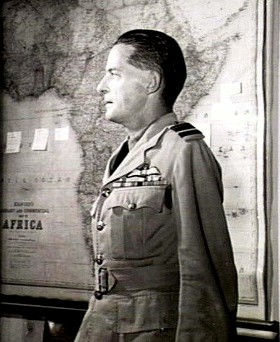Drummond, Peter Roy Maxwell
- Date of birth:
- June 2nd, 1894 (Perth/Western Australia, Australia)
- Date of death:
- March 27th, 1945 (Azores)
- Mentioned on:
- Air Forces Memorial Runnymede
Plot: Panel 264. - Nationality:
- Australian
Biography
Do you have more information about this person? Inform us!
- Period:
- First World War (1914-1918)
- Rank:
- Temporary Second-Lieutenant
- Unit:
- No. 67 Squadron, Royal Flying Corps
- Awarded on:
- August 14th, 1917
- Period:
- First World War (1914-1918)
- Rank:
- Temporary Captain
- Unit:
- No. 111 Squadron, Royal Flying Corps
- Awarded on:
- June 14th, 1918
- Period:
- First World War (1914-1918)
- Rank:
- Temporary Captain
- Unit:
- No. 111 Squadron, Royal Flying Corps
- Awarded on:
- July 23rd, 1918
On 27 March 1918, again near Tul Karem, Drummond and another pilot scrambled to attack a German scout. As his wingman dealt with the intruder, Drummond, flying a Nieuport, single-handedly engaged six other German aircraft that had suddenly appeared. After he had destroyed one and "sent another down in a spin", Drummond developed engine trouble and had to land behind enemy lines. Finding his engine firing again, he took off before he could be captured by Turkish troops and gained a start over the four still-circling German scouts, "who had also concluded that the fight was over". Drummond was forced to land three more times in enemy territory—once in a cavalry camp where he "carried away a line full of washing" with his undercarriage in his escape—before he shook off all but one of the pursuing fighters and landed safely behind Allied lines.
- Period:
- Second World War (1939-1945)
- Rank:
- Temporary Captain
- Unit:
- No. 111 Squadron, Royal Flying Corps
- Awarded on:
- August 23rd, 1918
"For conspicuous gallantry and devotion to duty. While escorting a reconnaissance, on three hostile planes being encountered he at once attacked and drove down one of these, although he was being himself attacked in the rear by the remaining two. Drawing these latter away from the reconnaissance machine, he turned, attacked and followed one of these down to a lower altitude, despite heavy anti-aircraft fire. This machine was then seen to strike the ground and turn over. He then attacked the third machine, and, after a long burst of fire at close range, both wings of the enemy plane were observed to collapse in the air. The whole action was characterised by the great skill and daring of this officer."
Awarded as bar on the ribbon of the first medal.
Awarded as bar on the ribbon of the first medal.
- Period:
- First World War (1914-1918)
- Rank:
- Acting Major
- Awarded on:
- June 5th, 1919
- Rank:
- Flight Lieutenant
- Unit:
- H Unit, Royal Air Force
- Awarded on:
- July 22nd, 1921
This officer performed most excellent work in command of H. Unit, Royal Air Force. Notwithstanding the adverse conditions that were met with, both at the aerodrome and in the air, the work performed by his unit in reconnaissance of the country and bombing expeditions, was one of the decisive factors leading to the success of the operations. The capable handling of his unit and the method of carrying out the duties assigned to him are deserving of the highest praise."
- Period:
- Second World War (1939-1945)
- Rank:
- Acting Air Marshal
- Unit:
- Deputy AOC in C, RAF Middle East, Royal Air Force
- Awarded on:
- September 23rd, 1941
- Period:
- Second World War (1939-1945)
- Rank:
- Air Vice-Marshal
- Unit:
- Deputy AOC in C, Middle East Command, Royal Air Force
- Awarded on:
- June 11th, 1942
- Period:
- Second World War (1939-1945)
- Rank:
- Temporary Air Marshal
- Unit:
- Air Member for Training, Air Ministry, British Government
- Awarded on:
- June 1st, 1943
- Period:
- Second World War (1939-1945)
- Rank:
- Temporary Air Marshal
- Unit:
- SASO, RAF Middle East, Royal Air Force
- Awarded on:
- May 3rd, 1946
Posthumously awarded
- Period:
- Second World War (1939-1945)
- Rank:
- Temporary Air Marshal
- Unit:
- SASO, RAF Middle East, Royal Air Force
- Awarded on:
- September 19th, 1946
Posthumously awarded
Sources
- - P R M Drummond
- https://www.thegazette.co.uk/London/issue/37553/page/2127/data.pdf
- https://www.thegazette.co.uk/London/issue/35284/supplement/5567/data.pdf
- https://www.thegazette.co.uk/London/issue/31383/supplement/7197
- https://www.thegazette.co.uk/London/issue/35586/page/2516
- https://www.thegazette.co.uk/London/issue/37729/supplement/4689
- https://www.thegazette.co.uk/London/issue/36033/supplement/2419
- https://www.thegazette.co.uk/London/issue/30234/supplement/8365
- https://www.thegazette.co.uk/London/issue/30862/supplement/9902
- https://www.thegazette.co.uk/London/issue/30813/supplement/8734
- https://www.thegazette.co.uk/London/issue/32398/page/5832









